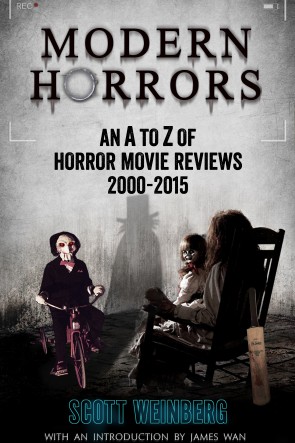Retro Review: THE LAST HOUSE ON THE LEFT (2009){0}
When it comes to remakes, the “horror faithful” can be a prickly lot. Make one like Prom Night and we complain about a lack of faithfulness to the source material, a softening of the chills in the name of a PG-13 rating, and a distressing prevalence of downright suckiness. (Yeah, maybe Prom Night wasn’t a great example to begin with…) But stick too CLOSE to the original film, and we all stand around wondering “What’s the point?” But I’ve always said that the best horror remakes are worth all the crappy ones, and if you focus on the films I’m referring to (let’s say: The Thing, The Fly, Dawn of the Dead, The Texas Chainsaw Massacre, and The Hills Have Eyes), then it looks like I might have a point. For every remake that’s “pretty good, not great” (like this year’s renditions of My Bloody Valentine and Friday the 13th), we’re subjected to a half-dozen that suck with the power of ten collapsed stars.
I’m not even sure why I told you all that, but it’s probably so I could lay down my perspective on horror remakes before making such a bold claim, but here goes: Not only is this new version of The Last House on the Left a vast improvement over its predecessor, it’s also one of the roughest, toughest, most confrontational horror films to ever slither out of the studio system. This is not the story of a haunted cell phone or a campfire tale about a loony slasher, but rather a film that touches upon real horror. The stuff that whirls through your head when your spouse is two hours late getting home, or when your daughter doesn’t answer her cell phone. This flick bolts right down one of those primal-fear hallways and just stands there for a bit. Quietly. Admittedly, this is not the kind of horror that appeals to casual fans. Folks who go “hmm, that could be fun” to a weekend screening of Friday the 13th are probably going to hate The Last House on the Left, if indeed they ever see it.
Based on the 1971 Wes Craven film of the same name — which itself was based on Bergman’s The Virgin Spring (which itself is based on a 13th century Swedish poem) — Last House tells an effectively simple tale: Two teenage girls are abused (horribly) by a gang of sleazy criminals and are left for dead in the forest. The criminals chance upon a nearby house, are welcomed in by the couple living there, and then discover (too late) that they’re sleeping in the house of their young victim. Cruel fate intervenes in favor of the couple: They figure out who the visitors are before the visitors discover who their hosts are. And then things get really ugly.
Harsh, dark, and admirably unflinching, the remake actually improves upon its predecessor by allowing one of its victims to (at least temporarily?) survive, which gives the parents (and therefore the audience) a new element to focus upon. Whereas the original was all about the evil that bad men do — and the evil that good men can easily succumb to — it was basically about us (the audience) rooting for revenge. (A simplistic thing to shoot for in a horror flick, I’ll admit, but it’s done with such raw power that the flick still packs a wallop after 25 years.) The remake adds a new wrinkle in that now we’re not just rooting for simple revenge, but also for escape. It’s a simple change, one that the purists may dislike, but I say it adds a lot to a fairly threadbare concept. (Also mercifully GONE from the remake: Bumbling cops!)
Much mainstream ink may be spilled over the film’s vicious rape scene and its proclivity for focusing on the basest side of humanity, but those are all just compliments in disguise. Romantic comedies and gung-ho action movies have no problem appealing to the “basic” human instincts, so I say horror films deserve the same shot. Plus, and this seems obvious to me, to LESSEN the horror of onscreen rape would be infinitely more reprehensible. But the lingering question will be: WHY? Why would anyone (even those who have no problem admitting their affection for monsters, mayhem, and movie-time misery) want to see a movie in which two lovely young women are raped and/or killed, only to have their attackers earn vicious retribution for their actions? Where’s the FUN in that?
To which I’d simply respond: Who said it was fun? Tremors is fun. Dance of the Dead is fun. The Last House on the Left is more like a frank and fascinating discussion about our collective fascination with pain, mortality, and violence. Like how most of the audience around me kept chuckling through Act I, but from the rape sequence forward, you could have heard a pin drop. Those viewers who’d “enjoyed” the first two kills in the film’s opening scene were now … dead sober and more than a little captivated. They wanted to know if the unrelenting evil would extinguish the small flicker of beauty, if any of the criminals had any sort of decency left, how far the good-hearted parents would go to avenge their child. This is a flick that bravely focuses on sections of human nature that we’d generally like to ignore, on that huge gray divide between “right” and “wrong,” and on terrors that hit a lot closer to home than some dude swinging a machete.
Clearly this is not a horror film for all tastes, and I don’t mean that in a “nyeah, they’re wimps!” sort of way. I find it completely reasonable that an individual would want to avoid a horror film with this sort of premise, conviction, or unflinching ruthlessness. This is not an “escapist” horror film. Aside from one goofy misstep (in the film’s final scene), this is as confident and crisp a studio horror film as you’re likely to come across. Masterfully directed by newcomer Dennis Iliadis (yes, I said ‘masterfully’ and I meant it), Last House delivers some early and very effective character development before setting up its tragic tale — and once the abductions have occurred, the movie is pretty much one straight hour of conflict, tension, and catharsis. Like the best horror films, it’s like a roller coaster. Only this one is Adults Only. Not simply because of the rape and murder, but because it takes a few years of experience for a story like this to truly affect you.
Easily one of the best horror remakes ever made (and trust me, I’ve seen them all), The Last House on the Left is bolstered by great performances (Tony Goldwyn, as the dad, is pitch-perfect: never a wimp and never a hero; lead villain Garret Dillahunt is fascinating in his hatefulness), a visual approach that’s as disconcertingly beautiful as it is unpredictably nasty, a “long take” editorial style that’s powerfully welcome in today’s hyper-cut horror world, and a subtly foreboding score by John Murphy. Reminiscent of films both recent (Funny Games, The Strangers) and classic (Straw Dogs, Deliverance), Last House ’09 is a brave, ballsy and audacious little film that knows what scares us … and will probably be detested for that knowledge.








